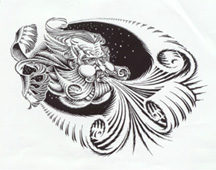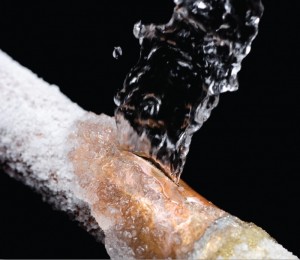Cold weather is on the way — winterize now and protect those pipes!
December 7, 2017Temperatures are dropping and the official start to winter is about two weeks away — if you haven’t done so already, it’s time to winterize the house, protect those pipes and wrap that meter.
Before the big chill hits, check your house to make sure your water meter and any water lines that are in unheated or exposed areas — for instance, a basement or crawl space — are either insulated or wrapped in heat tape. Foam pipe-wrap insulation and heat tape are available at most hardware and big box stores. If you’re unsure how to do this, contact a licensed plumber.
Ensure that any water to an outside source (such as a garden-hose hookup) has been turned off. There’s usually a shutoff valve inside the house somewhere. Once it’s shut off, drain that outside faucet, leaving it open a bit to ensure that if any water is still trapped inside, it will expand out the opening when it freezes, not expand and crack the pipe.
 It’s also a good time to button up your house. Expanding, spray-foam insulation is a fairly inexpensive way to do this, and can be used to close up areas where wires or pipes enter the house through a wall or foundation. It can also be used to seal up larger gaps around windows and door trim.
It’s also a good time to button up your house. Expanding, spray-foam insulation is a fairly inexpensive way to do this, and can be used to close up areas where wires or pipes enter the house through a wall or foundation. It can also be used to seal up larger gaps around windows and door trim.
Check the caulking around windows and doors, too: if it’s peeling or cracked, remove the old caulk carefully and replace it with a newer, silicone-based formula that will last for years to come. If you have storm windows, now is the time to remove the summer screens and install this extra layer of protection. If you know your windows are drafty, invest in some plastic window wrap. This will keep cold winter air out, and warm air in.
Insulate those outlets, too: You can purchase inexpensive outlet and switch insulators at most hardware and big-box stores. They’re usually made of foam, and are placed under the outlet cover to block cold air from outside walls.
Gaps under doors often leave the uninvited cold air in, so install a door sweep — there are a number of types that have an adhesive backing, so no drilling is required. If you can’t do that, at least invest in (or make) a doorstop, which will block the cold air.
If your electric water heater isn’t insulated (see the image at the beginning of this article) now’s the time. You can purchase kits at hardware and big-box stores. Leave gas-powered water heaters to the pros — mistakes with these could cause a fire or the venting of deadly carbon monoxide into your home.
If you’re renting and can’t make all these changes, there are still a number of affordable options to let Old Man Winter know he’s not invited inside.
A recent article from Rodale’s Organic Life offered this advice:
- Run Ceiling Fans In Reverse — Doing so reverses the direction of the fan blades, turning them clockwise … Clockwise blades will push warm air coming out of your heater downward, counteracting heat’s tendency to rise to the ceiling. Set the fan to its lowest level to get this effect without feeling air moving in the room.
- Cover Walls, Floors, Even Ceilings — If you are a renter, you don’t have control over how—or whether—your building is insulated. But you do have control over the walls in your unit. Quilts hung on exterior-facing walls have the same effect they have draped over a bed; they keep heat in. Choose quilts or other wall hangings that match your décor, and decorate as you winterize!
- Tuck your windows in for the winter with thick panel drapes or cellular or honeycomb blinds.
- Then turn to your floors, which can be covered with eco-friendly recycled rubber mats or—for a warmer feeling on your stocking feet—used area rugs whose previous lives were in smoke-free homes.
- Make The Most Of Sunny Windows — Use a principle called “passive solar heating” to put the sun’s rays to use without any equipment or gadgets. All you have to do is take inventory of how sunlight moves across your home during the day, and leave blinds that get a solid block of sun exposure open. You will get the most sun from south-facing windows. Even on a very cold day, the power of the sun will noticeably warm your indoor air.
- Clean Radiators And Vents — Keeping a clean home has many virtues, one of which is to allow for maximum heating efficiency in the winter. Radiators, hot air vents, and baseboards collect an alarming amount of dust which, over time, settles and cakes on the very mechanisms you’re asking to warm up your winter. A bristle brush is a great tool for swirling in the nooks and crannies of a radiator, baseboard, or vent, followed by a thorough vacuum job using the bristle attachment or small flat attachment to suck up every dusty bit. The more dust-free your radiators, baseboards, and air vents, the less energy your heating system will need to use to keep the room at the desired temperature. As a bonus, being mindful of dust in your heater will cut down on mites, dander, and other indoor allergens.

Finally, if your pipes do freeze when the cold weather hits, do NOT use a torch to thaw them. Instead, use a hair dryer to thaw them slowly. Torches are the most common cause of house fires when they’re used to thaw pipes.
If a pipe ruptures during a freeze, find the shut-off valve and turn off the water. This is often located on the main service line. You may also have separate shut-off valves for outside pipes or other areas in the house.
If you have any questions or service issues this winter, don’t hesitate to contact us.